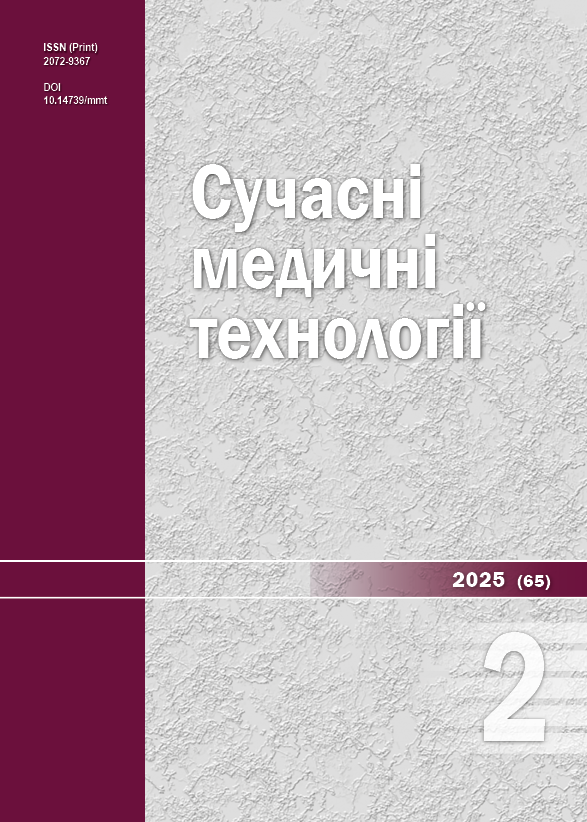Varicose veins in the anterior accessory great saphenous vein system of the lower limb
DOI:
https://doi.org/10.14739/mmt.2025.2.324994Keywords:
varicose veins, varicose veins in the anterior accessory great saphenous vein system, great saphenous vein, blood reflux, crossectomyAbstract
Aim. In order to improve the results of the treatment of patients with varicose veins and to prevent the recurrence of the disease, a quantitative analysis of the types of varicose veins in the anterior accessory great saphenous vein (GSV) system should be carried out according to the source of their reflux.
Materials and methods. In the vascular department of the Transcarpathian regional hospital named after A. Novak in Uzhhorod, we treated 3000 patients with varicose veins of the subcutaneous veins of the lower extremities in 2018–2025. Varicose veins in the anterior accessory great saphenous vein system were noted in 111 (3.7 %) patients. Inclusion criterion for the study: diagnosis of varicose veins of the lower extremities with varicose veins in the anterior accessory GSV system was established using ultrasound examination of the superficial and deep veins of the iliofemoral segment. Exclusion criterion: the presence of concomitant serious diseases. In type I, the varicosed anterior accessory great saphenous vein flows into the GSV in its upper third, and in type II, the varicosed trunk is not connected with the GSV.
Results. Among patients with type I varicose veins in the system of the anterior accessory great saphenous vein 49 (55.1 %) patients, variant 3 was observed, which corresponded to classical varicose disease with a single dilation of the GSV and its tributaries. The second place was taken by 31 (34.8 %) patients with maximum dilation of the GSV, where the varicose GSV passes into the lateral vein, and distal to the GSV was not dilated. In type II varicose veins in the anterior accessory great saphenous vein system in 13.6 % of cases the source of reflux was incompetent perforating veins from the deep femoral vein, in 27.3 % – incompetent perforating veins connected to the common femoral vein. In more than 59.1 % of patients with type II varicose veins in the anterior accessory great saphenous vein system the source of reflux was the iliofemoral basin connected through the perforating veins of the inferior gluteal vein.
Conclusions. The optimal approach to the classification of varicose veins within the anterior accessory great saphenous vein system is based on the source of reflux. In the case of type I varicose veins in the anterior accessory great saphenous vein system, classical phlebectomy of the GSV is effective in any way. However, in the case of type II varicose veins in the anterior accessory great saphenous vein system, it is necessary to eliminate the perforating veins, which are the source of reflux from the iliofemoral segment.
References
Alozai T, Huizing E, Schreve MA, Mooij MC, van Vlijmen CJ, Wisselink W, et al. A systematic review and meta-analysis of treatment modalities for anterior accessory saphenous vein insufficiency. Phlebology. 2022;37(3):165-79. doi: https://doi.org/10.1177/02683555211060998
Svidersky Y, Goshchynsky V, Migenko B, Migenko L, Pyatnychka O. Anterior accessory great saphenous vein as a cause of postoperative recurrence of veins after radiofrequency ablation. J Med Life. 2022;15(4):563-9. doi: https://doi.org/10.25122/jml-2021-0318
Nicolaides A, Kakkos S, Baekgaard N, Comerota A, de Maeseneer M, Eklof B, et al. Management of chronic venous disorders of the lower limbs. Guidelines According to Scientific Evidence. Part I. Int Angiol. 2018;37(3):181-254. doi: https://doi.org/10.23736/S0392-9590.18.03999-8
Zulfiquar MK, Awais M, Javeed SJ, Naeem S, Waheed A, Khan R, et al. To assess short term outcomes of Ambulatory Selective Varices Ablation under local anesthesia in primary varicose veins. Pakistan Journal of Medical and Health Sciences. 2022;16(4):139-41. doi: https://doi.org/10.53350/pjmhs22164139
Alsaigh T, Fukaya E. Varicose Veins and Chronic Venous Disease. Cardiology clinics. 2021;39(4):567-81. doi: https://doi.org/10.1016/j.ccl.2021.06.009
Abud B, Kunt AG. Midterm varicose vein recurrence rates after endovenous laser ablation: comparison of radial fibre and bare fibre tips. Interact Cardiovasc Thorac Surg. 2021;32(1):77-82. doi: https://doi.org/10.1093/icvts/ivaa219
Vasudha S, Sabita P, Prakash GV, Nagamuneiah S, Ahmed Sheriff, Hima Bindu. A cross-sectional study of complications and management of varicose veins at SVRRGGH, tirupati. J Evid Based Med Healthc. 2021;8(23):1954-9.
Müller L, Debus ES, Karsai S, Alm J. Technique and early results of endovenous laser ablation in morphologically complex varicose vein recurrence after small saphenous vein surgery. PLoS One. 2024;19(10):e0310182. doi: https://doi.org/10.1371/journal.pone.0310182
Fayyaz F, Vaghani V, Ekhator C, Abdullah M, Alsubari RA, Daher OA, et al. Advancements in Varicose Vein Treatment: Anatomy, Pathophysiology, Minimally Invasive Techniques, Sclerotherapy, Patient Satisfaction, and Future Directions. Cureus. 2024;16(1):e51990. doi: https://doi.org/10.7759/cureus.51990
Baccellieri D, Ardita V, Carta N, Melissano G, Chiesa R. Anterior accessory saphenous vein confluence anatomy at the sapheno-femoral junction as risk factor for varicose veins recurrence after great saphenous vein radiofrequency thermal ablation. Int Angiol. 2020;39(2):105-11. doi: https://doi.org/10.23736/S0392-9590.20.04271-6
Anuforo A, Evbayekha E, Agwuegbo C, Okafor TL, Antia A, Adabale O, et al. Superficial Venous Disease-An Updated Review. Ann Vasc Surg. 2024;105:106-24. doi: https://doi.org/10.1016/j.avsg.2024.01.009
Chen T, Liu P, Zhang C, Jin S, Kong Y, Feng Y, et al. Pathophysiology and Genetic Associations of Varicose Veins: A Narrative Review. Angiology. 2024:33197241227598. doi: https://doi.org/10.1177/00033197241227598
Gwozdz A, Kavallieros K, Turner B, Stoughton J, Davies A. Exploring patterns of recurrent varicose veins after surgery (REVAS): A systematic review and network meta-analysis of randomized controlled trials. J Vasc Surg Venous Lymphat Disord. 2025;13(2):102081. doi: https://doi.org/10.1016/j.jvsv.2024.102081
Pyne R, Shah S, Stevens L, Bress J. Lateral Subdermic Venous Plexus Insufficiency: The Association of Varicose Veins with Restless Legs Syndrome and Nocturnal Leg Cramps. J Vasc Interv Radiol. 2023;34(4):534-42. doi: https://doi.org/10.1016/j.jvir.2022.12.019
Welch HJ. Combined treatment of the anterior accessory saphenous vein and the great saphenous vein. Vasc Endovasc Rev. 2022;5:e01. Available from: https://verjournal.com/combined-treatment-of-the-anterior-accessory-saphenous-vein-and-the-great-saphenous-vein/
Downloads
Additional Files
Published
How to Cite
Issue
Section
License
Copyright (c) 2025 V. I. Rusyn, F. M. Pavuk, M. I Borsenko, N. M. Popovych, V. V. Rusyn

This work is licensed under a Creative Commons Attribution-NonCommercial 4.0 International License.
The work is provided under the terms of the Public Offer and of Creative Commons Attribution-NonCommercial 4.0 International (CC BY-NC 4.0). This license allows an unlimited number of persons to reproduce and share the Licensed Material in all media and formats. Any use of the Licensed Material shall contain an identification of its Creator(s) and must be for non-commercial purposes only.














